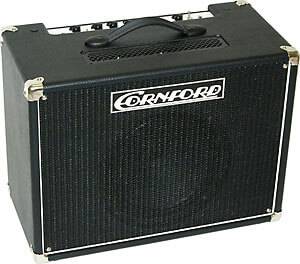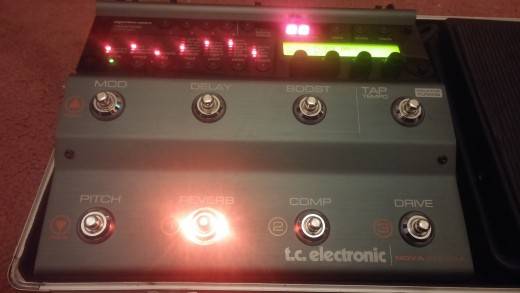Review of the Cornford Roadhouse 30 – A 30 watt, all-valve (2x 6l6, 3x 12AX7) 1×12 guitar combo amplifier, made in the U.K.
My first boutique guitar amplifier?
Not quite, the Cornford Roadhouse series was essentially Cornford’s “Budget” PCB range. I say ‘was’ because Cornford Amplification sadly ceased trading mid-2013, with its chief designer Martin Kidd eventually moving on to form Victory Amplification.
Even so, The Roadhouse 30 still initially retailed at around £1000, receiving rave reviews, most notably a rare Five Star Gold Award from Guitarist Magazine. At the time the Cornford Roadhouse 30 was out of my price-range, until Andertons bought out what was rumoured to be the remaining Roadhouse stock and dropped the price to £599.
Features
The Cornford Roadhouse 30 keeps it simple, with a 3-band EQ, gain, master volume and ‘boost’ chicken-head knobs. The boost is foot-switchable and adds additional ‘mosfet’ gain. This is the Roadhouse 30’s first disappointment, as you can’t tailor the boost with EQ or volume, it’s simply just a very limited (although fantastic sounding) gain boost. What this means in practice is that when running the amp dirty, the gain boost doesn’t give you enough volume increase (or for that matter EQ tailoring) to push your tone above the mix for solos. On the other hand, if you run the amp cleaner, the gain boost gives you too much of a volume boost. It’s a very fine balancing act to set up the Cornford Roadhouse 30 as a two channel amp and one I couldn’t achieve, although in fairness it was never advertised as a two-channel amp anyway.
A series effects loop is also included with no additional options for different levels etc, something I don’t miss at all, and lastly a single guitar input. Again I much prefer this to something like Laney’s hi and lo inputs for example. Much cleaner and straightforward.
There’s no mod-cons like in-built effects (even reverb), emulated line-outs or USB connectivity here. Again, I didn’t miss them as I always mic up if needed and I use guitar modelling for recording anyway. For reverb, my trusty Zoom G3 always did the trick in the FX loop.
Build Quality
The Cornford Roadhouse 30’s circuitry is housed is an over-sized 600 mm (W) 460 mm (H) 300 mm (D) cabinet constructed in the UK from 19 mm, lock jointed solid pine with metal corner protectors. The chassis itself is also pretty bullet-proof, with metal shafts on all the pots (unlike my Fender Blues Junior III which features plastic shafts). Very good start.
However, the cabinet and chassis together (well in excess of the head’s 25kg) make for back-breaking trips to and from the gig, which isn’t helped by the pitiful carry-handle which quite frankly isn’t up to the job. Mine actually started to fall apart after about a year, with the rubber handle gradually coming away from the metal strip precariously holding the weight of the amp. It never actually snapped off, but it didn’t exactly inspire confidence either.
The tolex covering was also always a worry, with the slightest knock incurring damage of some sort, be it a rip or a scratch. Nothing an amp cover wouldn’t have solved (not included in the price) but I couldn’t help thinking that, no matter how expertly it had been applied, the covering seemed a little on the thin side. Give me something like the tough tweed covering of the new Fender BassBreaker amplifiers any day.
Similarly weedy is the grille-cloth which isn’t stopping anything damaging the speaker. I’d much prefer a lightweight aluminium grille
Another small but irritating issue are the nut threads of the jack-sockets. At first glance they look like really good quality metal with nice rubber washers, but in practice they just keep loosening themselves. After tightening them up for the twentieth time, this gets tedious.
Access to the valves isn’t exactly straightforward either, you can’t get to them without removing the four screws of the back-plate and the two main chassis screws, I wouldn’t like to have to perform this task mid-gig.
Lastly, for a £600 amp I would have really liked an upgrade from the four plastic feet to something like the wooden beams of my old Orange Rocker 30 C.
All in all, Cornford same to have got the build-quality basics right, but let the side down in the details, resulting in an amp that’s a lot more delicate and vulnerable than it should have been.
Sound
The combination of an over-sized cabinet and a humbucker equipped guitar results in an expansive but very bass-heavy tone, surprising given the Celestion Vintage 30 speaker, which is famed for its mid frequency emphasis. In A-B tests with other amps (in particular my Fender Blues Junior III) the Cornford Roadhouse 30 always produced a bigger tone, more natural , direct and ‘in your face’, as though the guitar lead was plugged directly into its input (when it wasn’t). In comparison the Fender Blues Junior III seemed to take something away from the tone and seemed more distant whilst adding brightness and ‘poke’.
Still, with the gain at just over half and the boost disengaged, this became my main amp rhythm tone for years, with just the right amount of gain to be able to clean up on the guitar volume, which the Cornford Roadhouse 30 does amazingly well. The tone sits between the square mid/high-mid bark of a Marshall and the softer (some say more distant-sounding) overdriven tones of something like a Boogie and, as a result, the Roadhouse feels under-powered in the mids/treble (and even gain) response to REALLY cut through. It’s a more refined tone, less edgy, which isn’t always what you want. Sometimes you just want ‘bite’. Volume wise, in a full-band scenario (one guitarist) un-miced, I seldom had the master volume above 4. In a two guitar band, never over 6. The Cornford Roadhouse 30 has volume to spare.
As explained above, the boost feature is pretty much useless as a lead boost (particularly as the footswitch doesn’t even have its own LED), so my first attempt was to add a clean boost in the effects loop (a Mooer Pure Boost), which gave me the required volume boost (and some EQ tailoring), but still no gain boost to really make it sing. A Tubescreamer or similar in the front-end was also a no-go as I was running the amp too dirty for a significant volume hike.
In the end I was left with a fabulously versatile overdriven rhythm sound which covered a lot of ground from pop to punk to hard-rock whilst cleaning up on the guitar volume if need be and a louder version of the same for lead, which wasn’t ideal. Of course you could always run the amp clean and go from there, but that’s not the reason why people buy Cornford amps!
Special mention has to go to the intuitiveness of the EQ, which behaves exactly as you’d expect in a sensible, usable range, with the treble adding cut but no shrillness, the mids adding push but no honk or dramatic hollowing-out and the bass adding or removing body and fullness. It was easy to predict the EQ settings without even looking and even easier to adjust them to what your ears were telling you in a very natural way. The old cliche is true, there are no bad sounds in the Cornford Roadhouse 30. Having said that, I wish the controls could’ve been a little less polite so that more extreme settings could be dialed in, for example a high gain/treble boosted Brian May style tone, or a scooped metal tone.
I can’t help thinking that the Cornford Roadhouse 30, with its soft-sounding, bass-heavy response, would be a better match for single-coil guitars, which would provide the cut this amplifier lacks. Then again, maybe I just would’ve been happier with a Marshall!
Reliability
Nothing really much to say here that hasn’t already been covered. Bullet-proof (and extremely heavy) construction with a flimsy covering and carry handle. In 3 years of gigging the Cornford Roadhouse 30 didn’t give me a single issue.
Conclusion
Taken as it is (a single channel amp) the Cornford Roadhouse 30 delivers its own flavour of high-quality, dynamic and versatile overdriven tones bridging the gap between the UK and the US in a solid, high-spec package. It could just do with a little more ‘oomph’ and flexibility in the gain / EQ to cater for more tastes.
Just do yourself a favour and try it with both single coil and humbucker equipped guitars.
You’ll also need to work out your own strategy to deal with the problem of a lead boost.
Full specs can be found at http://www.cornfordamps.com/



